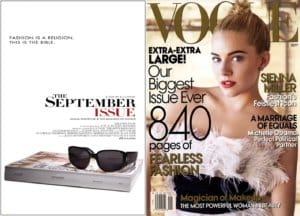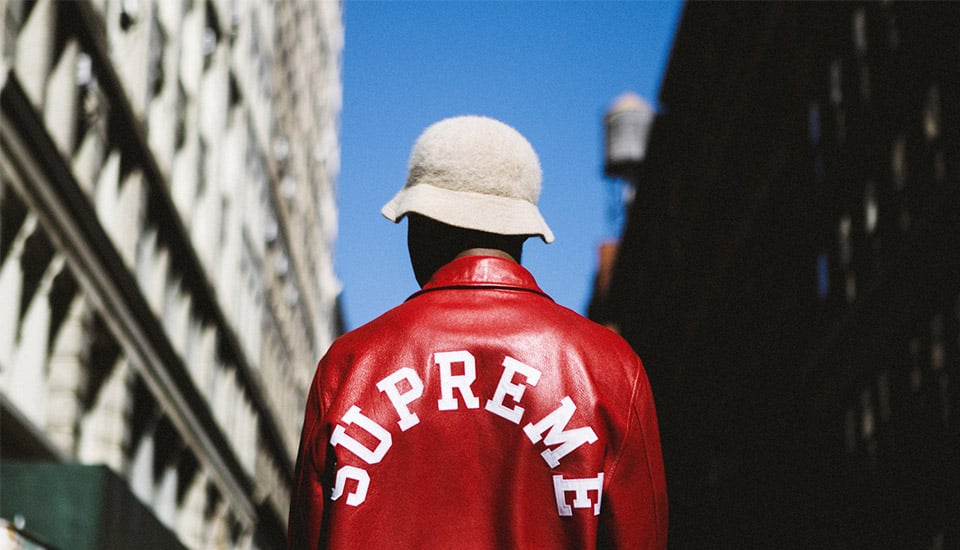Visual search facilitates the trickling down of inspiration from glossy magazines, through social media influencers to each and every one of us. Today, everyone has the right to vote with his or her wallet and a camera.
“I think what I often see is that people are frightened of fashion, and that because it scares them or it makes them feel insecure, they put it down. On the whole, people that say demeaning things about our world, I think that’s usually because they feel in some ways excluded or, you know, not part of the cool group. So, as a result, they mock it.”
With this statement, Anna Wintour opened the documentary, The September Issue, released in 2009 when Vogue and other publishers such as Harper’s Bazaar, W, and Elle were the fashion bibles that picked the clothes shoppers wanted to buy and retailers had to sell.
 Source: Fashionatclick
Source: Fashionatclick
Not long ago, fashion was a highly exclusive and selective industry that tended to discount a lot of demographics. For consumers with diverse personalities who get inspired by many things beyond those presented on glossy magazines and displayed in store windows, the choices were limited.
The way fashion works eventually changed a decade later. Today, the rise of digital, social media, and visual search technology shifted the power from publishers and retailers to consumers. From mere watchers of fashion trends, consumers are now the leaders.
“Before, it used to be the department stores who were in charge, now the customer is in charge because technology has really given the customer access to so much information. They have high expectations and they can go on an app and compare pricing, globally, instantaneously,” Tory Burch shared.
Enter the influence of social media and personalities
Consumers get inspiration from everywhere but one of the default sources that emerged in recent years is social media. According to a PricewaterhouseCoopers (PwC) survey, in terms of inspiration for purchases, 37% chose social networks as their number one source, while 20% specifically cited visual social networks such as Snapchat and Instagram.
Social media made fashion more inclusive for shoppers. Retailers, designers, and brands are now more inclined to share their world to attract today’s dynamic consumers. Even Instagram has its own fashion department that teams up with key fashion players and shares engaging content with users.
Business of Fashion, together with McKinsey & Company (BoF-McKinsey), reported that nine out of ten consumers trust an influencer more than traditional advertisements or celebrity endorsements. For instance, it has become a norm to see Chiara Ferragni, Aimee Song, and Camila Coelho, who have millions of Instagram followers and engaged communities, get invited to Fashion Week shows.
In addition, visual social networks expand trends that shoppers like and so retailers and designers have to provide. A great example is luxury streetwear which evolved from the skate and hip-hop culture that gave emphasis to logo-heavy sportswear. Driven by social media savvy, visually-driven, young consumers who value uniqueness and loud aesthetic, luxury streetwear boosted luxury goods sales by five percent (or 263 billion euros) in 2017.
 Source: Iprice
Source: Iprice
Visual search makes it possible for everyone
Being inspired is one thing. Translating the inspiration into reality is another and that is what matters more for consumers. Visual social networks are one way to jumpstart the product discovery process, but it is with the power of visual search that completes the entire shopping experience up to purchase.
Business Insider Intelligence revealed that 39% out of 12 million global respondents chose apparel as the retail category that they use visual search for the most. To address the demand, fashion retailers such as Farfetch and Marks & Spencer already allow consumers to search products using images.
Across industries, 32% of brand leaders are leveraging visual search technology as of 2018, according to eMarketer. Plus, the Image Recognition Market as a whole looks promising, with Deloitte estimating it to grow to almost 39 billion dollars by 2021.
Visual search gives consumers abundant choices.
While social media makes fashion inclusive, it is visual search that makes fashion accessible to all demographics across segments—from mass to luxury. For instance, a consumer inspired by an haute couture dress can simply run a visual search, immediately choose from look-alike dresses across price ranges, and get style ideas from user-generated fashion content.
Visual search expands the purchasable inspiration of consumers.
Beyond social media, visual search transforms any real-world item that inspires consumers into purchasable products. On top of Instagram screenshots, shoppers can search any image of interest and get unique, visually similar items in a huge assortment.
Visual search offers personalization at scale.
A more inclusive and accessible fashion industry ignites the individuality of consumers, partly explaining why BoF-McKinsey Global Fashion survey respondents considered personalization as the number one trend in 2018. With its availability throughout the entire shopping journey, visual search makes it simple and easy for consumers to find, compare, and buy anything they want.
Visual search delivers the holy grail of retail—omnichannel experiences.
Despite grim headlines about brick-and-mortar stores closing worldwide, PwC found that weekly physical shoppers increased from 40% (2016) to 44% (2018). Besides the “order online, pick up in store” option, in-store visual search technology can encourage brick-and-mortar store visits as it helps consumers synchronize product search online and offline. With an in-store smart mirror, shoppers can browse social media images and similar items within the brick-and-mortar store based on what they are trying on, creating a customer experience worth leaving the house for.
In addition to consumers, visual search levels the playing field for retailers, designers, and brands. Much like social media, it gives companies of any size the opportunity to reach and engage consumers. From product exposure to brand loyalty, visual search empowers retailers, brands, and designers to stay on top of the latest trends that shoppers consider “in” and therefore, want to wear.
At its core, the democratization of fashion led by social media but amplified multifold by visual search reflects a consumer-driven reaction to a once restricted world. A reaction-movement that taps into consumers’ inherent desire to express individuality which has long been suppressed (albeit unintentionally) by a selected few of the fashion industry.
Time to jump on the next frontier
Adding visual search on desktop and mobile with Syte fulfills the shopping experiences of consumers—from product discovery to purchase. With visual search, shoppers in all shapes and sizes enjoy the freedom, the choice, and the convenience to find the items that inspire and help them express themselves—which is exactly what fashion is all about.
In the words of Anna Sui, “Clothing is so magical. You can really use it to create yourself in a certain way. It’s kind of a vocabulary of expressing yourself.” And with Syte’s visual search AI solutions, no words are needed to translate self-expression through fashion—only images.